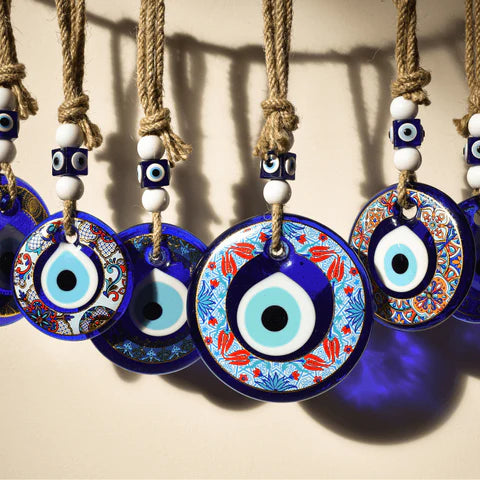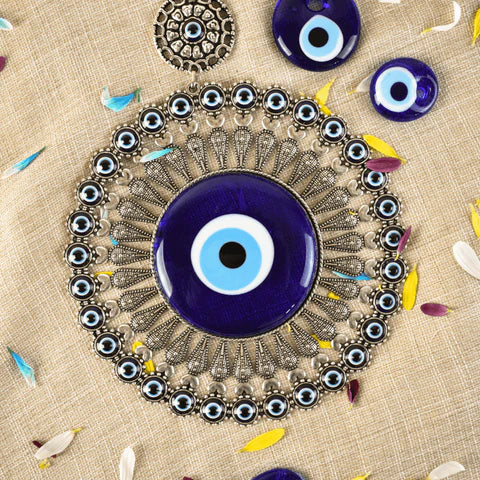Evil Eye: Everything you Need to Know About the Meaning and Protection
The evil eye has been part of many cultures worldwide for about 3,000 years, dating back to the ancient Greeks and Romans. As a result, it's instantly recognizable and one of the world's most powerful symbolic images.
Frequently seen worn because of the belief that it can block the powers of evil. We covered everything you need to know about it, including why it's a part of almost every culture and religion, including Christianity, Islam, Judaism, Hinduism, and Buddhism.
Key Takeaways
- Ancient Symbol: An ancient symbol with origins dating back 3,000 years, widely recognized and powerful globally.
- Protection And Threat: Symbolizes protection against jealousy, greed, and malice, offering safety and fulfillment of dreams.
- Cultural Variations: Interpreted differently across cultures, representing a threat to pride (Greek), the power of the eye and jealousy (Hindu), and fear of bad luck (European).
- Hidden Evil Eye: The hidden evil eye, the most formidable form, is believed to see all the world's evil and has the power to instill curses through jealous intentions.
- Modern Influence: Maintains a strong presence in modern life, influencing jewelry, fashion, design, and pop culture, particularly notable in Turkey.
- Evil Eye Jewelry: Popular jewelry design featuring a human eye on a blue background, worn for protection and widely endorsed by celebrities.
- Colors and Meanings: Different colors of the evil eye symbol carry specific meanings, such as dark blue for good karma and red for energy and courage.
- Superstition And Fame: Reflects a contemporary belief that excessive fame, money, or success might attract downfall, especially in celebrity culture.
- Symbolism Across Cultures: Represents protection, a threat to pride (Greek), the power of the eye and jealousy (Hindu), fear of bad luck and witches (European), and the superstition of the "fat eye" (Brazilian).
- Global Symbol Of Protection: Despite cultural variations, remains a universally powerful symbol believed to ward off misfortune and harm.
History of the Evil Eye symbol
| Period | Key Events and Beliefs |
| Ancient Greece | The earliest evidence of belief |
| Ancient Rome | Influence on people's behavior |
| Modern Day | Popularization of the symbol in different cultures |
The earliest evidence for belief of this can be traced back to ancient Greece and Rome. People consider the evil eye as the most significant threat to someone who people praise too much or have more admiration than they truly deserved.
That person would become swollen with pride and bring about their doom via the evil eye. The curse to cause physical and mental illness is one of its powers.
When the people became too proud because of their accomplishments, the gods and goddesses chastened them. They would destroy them with its power and restore them to the level of ordinary mortals.

What Does it Symbolize?
This famous symbol is widespread and seen many times. Some people wear it as a bracelet or necklace and talisman. Sometimes you can witness a person giving the appearance of an "evil eye."
Regardless of one's religious background or the religion from which the it is derived, the karmic essence is the same and should be shared. People are fond of this sacred symbol because of its deep meaning.
The Evil Eye symbol promises you will be secure and safe, which is essential for fulfilling your dreams. There is nothing more magical than its protection, as its rich "experience" in ensuring the safety of people all over the world is the most promising fact.
Meaning of Evil Eye
- Evil eye beliefs are widespread, with concerns in Asia, Europe, and Central America.
- In Islamic culture, excessive praise is believed to bring harmful effects of the evil eye.
- Hinduism attributes powerful energy emission to the eye, associating the evil eye with jealousy.
- Animals, including snakes, are thought to be capable of casting the evil eye in Hinduism.
- While men can cast the evil eye, Hindu tradition suggests women are more common recipients, leading to protective practices in South India.
- In Europe, the belief in the evil eye stems from the idea that jealous or spiteful looks can bring bad luck.
- Unusual eye colors, like red eyes in Germans and squinty eyes in Irish, are associated with possessing the evil eye.
- In Italy, a unibrow is seen as a sign of casting an evil eye.
- Brazil has a superstition called the "fat eye," akin to the evil eye, with dishonest compliments considered risky.

Ways of Protection Against it
| Cultural Practice | Protective Items Used |
| Greek | Evil eye amulets, incense, crosses |
| Hindu | Black eye paint, symbolic objects |
| Middle Eastern | Nazar amulets, specific items under pillows |
- Greek culture employs evil eye amulets, crosses, and incense for protection against the curse.
- Mothers place various items under the pillows of newborns, such as strings, nails, gunpowder, salt, rings, and indigo blue, or silver buckles.
- Each item symbolizes a specific quality: gunpowder represents the ability to fight the evil eye, a nail symbolizes strength, indigo blue holds power in its color, and salt symbolizes preservation and strength.
- There are three types of evil eyes: unconscious harm, intentional harm, and hidden evil.
- The hidden evil eye is considered the most terrifying, believed to see all the world's evil and remove poverty and ignorance.
- The concept of the evil eye talisman originated in Egypt with the story of Horus, spreading to the Mediterranean, the Middle East, and Europe.
- When someone envies something good, it is believed they transmit harmful qualities into the surrounding air through their jealous exhalations.
RELATED: 178 Uplifting Quotes To Bring Joy & Laughter To Your Life
Amulets and Talismans
Phrases and rituals aren't the only way to ward off the evil eye's power. In many cultures, the usage of evil eye talismans, symbols, and jewelry is the most popular way to avoid the evil eye's effects. These are designed to "mirror" the evil look's power.
For example, this amulet originated from Greece and was regarded as an "apotropaic" amulet, reflecting harm.
The Nazar, a talisman with concentric blue and white circles to signify the evil eye, is the primary design popular in the Middle East. It's frequently seen on houses, automobiles, and jewelry.
The Modern Life of the Evil Eye
| Pop Culture Item | Influence and Representation |
| Movies | Themes, characters, and plotlines |
| Music | Lyrics, album covers |
| Fashion | Celebrity endorsements, design trends |
It continues to have a strong hold on modern life, jewelry, fashion, design, and even pop culture. The expression "the evil eye" is so well-known that everyone has heard of it, and you may even know someone who has cast a malevolent glare once or twice.
In Turkey, evil eyes are strongly ingrained in people's daily lives and play a significant role in their culture. This curse have an association with everything that could attract jealousy, greed, or malice.
It can now be discovered in Turkish homes and businesses, on currency, on the necks of newborn children and farm animals, and even in the foundations of buildings.
The basic design of the evil eye bracelet and necklace is one human eye on a blue background. The great thing about this bracelets is that they can be made with many powerful and beautiful stones to increase the intention. Each culture puts its own colors based on local beliefs and legends.
Evil eye jewelry for men is usually found only as a necklace. When someone casts a curse, the pendant returns it, which benefits a wearer.
However, this ancient concern has made its way into different jewelry designs. You can find the evil eyes on rings, bracelets, anklets. There are many different styles of bracelets, especially if you are a collector.
Evil Eye Jewelry
| Jewelry Style | Design Features |
| Bracelets | One human eye on a blue background |
| Necklaces | Incorporation of powerful stones |
| Rings | Different styles for collectors |
This is a very popular piece of jewelry design in the present. In addition, many celebrities have been seen wearing red Kabbalah bracelets in everyday life, which offer another form of protection against the curse.
Because celebrities like Kim Kardashian and Rihanna have worn this amulet in public, the evil eye's iconic and stylish image has only grown in popularity.
The meaning of the evil eye varies amongst different cultures, but charms and ornaments are the connection factor through all of them.
In countries such as Egypt, Greece, Turkey, Lebanon, Iraq, Iran, Morocco, Southern Italy, and Afghanistan, eye-like symbols popular as Nazars have been useful to ward off the evil forces.
This jewelry has a simple design with a deep blue background and a central eye regardless of the area.

Whether someone believes in the magic behind this or not, there's no harm in wearing a charm designed for protection against ill will and misfortune.
RELATED: 320 Wonderful Good Morning Quotes To Begin Each Day
Hamsa and Evil Eye Meaning
The Hamsa is an equally powerful charm as an evil eye charm, symbolizing the same benefits. It is one of the most effective amulets in Africa and the Middle East.
The Hamsa, often known as the "Hand of Fatima," resembles a hand with it on its palm. People make it as jewelry or wallpaper to ward off the effects of a curse.
In Jewish culture, the Hamsa is referred to as "the hand of Miriam" or "the hand of God." The popularity of the Kabbalah has risen in recent years. As a result, designers have considered how the Hamsa is constructed for jewelry and accessories.
RELATED: 185 Fabulous Positive Affirmations
Evil Eye meaning for each color
| Eye Color | Meanings |
| Dark Blue | Good karma, protection |
| Red | Energy, courage |
| White | Purity, clarity |
| Gold/Yellow | Concentration, health protection |
The evil eye's most common color is dark blue, just like the Greek seas. This color and its original interpretation has symbolized diverse meanings because of the added numerous colors.
Colors of the Evil eyes and its meaning
Dark Blue
Traditional color for good karma, protection against the evil eye, positive energies, calmness, smooth communication, and fate protection.
Light Blue
Broadens perspective, and offers peace, solitude, and general protection.
Orange
Used for protection, happiness, playfulness, creativity, motivation, and commitment.
Dark Green
Brings balance, and freedom for new dreams, and promotes happiness.
Light Green
Promotes good health, guides success with dreams, and brings contentment.
Red
Boosts energy, enthusiasm, and courage, and protects from fears and anxieties.
Brown
Connects with nature, protects from elements, and provides convention and order.
Purple
Removes obstacles, re-balances life, and boosts imagination.
Gold or Yellow
Relieves exhaustion, enhances concentration, sharpens the mind, and protects health.
Gray
Reduces color intensity, opens the mind to new situations, and protects from sorrow.
White
Clears clutter and obstacles, allows a fresh start, and gives focus and purity.
Pink
Provides relaxation, contentment, and a calming feeling, and protects friendships.
Is The Evil Eye just a Myth?
Surprisingly, in today's world, the evil eye myth makes a lot of sense. The belief that too much fame, money, success, or praise might lead to one's downfall, especially in celebrity culture, may strengthen the evil eye.
Lindsay Lohan and, more recently, Charlie Sheen are both examples of how success can be disastrous. Is it possible that Lindsay would be in better shape if she had worn the evil eye sooner? Millions of believers would undoubtedly agree with that.
But, whatever is true, people who are frequently in the spotlight, such as celebrities or those who have achieved success or have reason to be proud, should most likely carry an evil eye with them.
What is The Superstition About The Evil Eye?
The evil eye is one of the most powerful symbols globally, and despite the beliefs, it remains popular in many cultures.
Giving the evil eye indicates that you want to cause pain, misfortune, or harm the object or person you're focusing on. The evil eye's superstition lives on today, with some claiming that the evil eye's malicious look alone is potent enough to bring actual disaster to those who receive it.
What Does the Evil Eye Represent in Different Cultures?
| Culture | Symbolism and Meanings |
| Greek | Protection, a threat to pride |
| Hindu | Power of the eye, jealousy as the root |
| European | Fear of bad luck, witches, unusual eye colors |
| Brazilian | The superstition of the "fat eye" |
While the meaning of the evil eye varies between cultures and eras, charms and talismans have been found in Europe and the Middle East dating back to the first century BC. These objects are types of apotropaic talismans.
The most frequent are disks or beads with concentric blue and white circles (typically dark blue, light blue, white, and dark blue from the center outward), which signify an evil eye.
The logic of this is to fight fire with fire. In Turkish, this form of talisman is known as a Nazar. It can be found on houses, cars, fishing boats, and even as beads in Turkey.
Tribal Kilim rugs are often made with various themes to ward off the evil eye. For example, a cross can divide it into four parts, a hook can kill it, and a human eye can avert the evil look. For the same reason, the shape of a lucky charm is frequently weaved into kilims.
It first appeared on clay tablets in cuneiform about 5,000 years ago. Christian, Muslim, Jewish, Buddhist, and Hindu cultures use the eye symbol.
The "evil eye" is a curse thought to be cast by a malevolent glare directed at someone unaware of it. It is widely considered to bring bad luck or even injury. Therefore, evil eye jewelry and talismans were made to protect from bad luck.
Frequently Asked Questions
What is the significance of evil eye symbols?
Evil eye symbols are believed to provide protection against negative energies and ward off the malevolent effects of jealousy or envy.
Where are evil eye symbols commonly found?
Evil eye symbols are prevalent in various cultures and can be found in jewelry, home decor, clothing, and accessories.
How do evil eye symbols work?
The symbols are thought to absorb or deflect negative energies, protecting the wearer or surroundings from the potential harm caused by the evil eye.
Are there different variations of the evil eye symbol?
Yes, evil eye symbols come in various forms, including beads, amulets, charms, and intricate designs, each with its cultural nuances.
What cultures embrace the concept of the evil eye?
The belief in the evil eye is widespread, with manifestations in Greek, Turkish, Middle Eastern, Indian, and Latin American cultures, among others.
Can evil eye symbols be used for decorative purposes?
Yes, many people incorporate evil eye symbols into their decor not only for their protective qualities but also for aesthetic purposes.
Are there specific colors associated with evil eye symbols?
Blue is a common color associated with evil eye symbols, symbolizing protection, but color variations can exist based on cultural interpretations.
How do individuals use evil eye symbols for personal protection?
People often wear evil eye jewelry or carry amulets to invoke protection against negative energies and the potential effects of the evil eye.
Can evil eye symbols be used in rituals or ceremonies?
In some cultures, evil eye symbols play a role in rituals or ceremonies aimed at dispelling negative energies or promoting good fortune.
Is belief in the evil eye still prevalent in modern times?
Yes, the belief in the evil eye persists in many cultures, and people continue to use symbols as a precautionary measure in various aspects of their lives.

